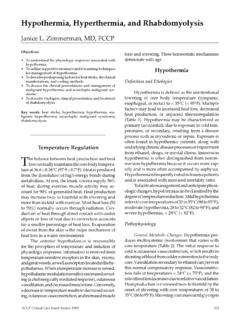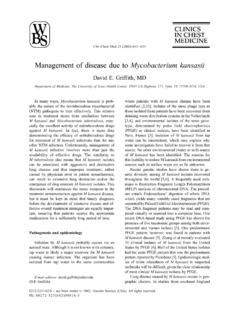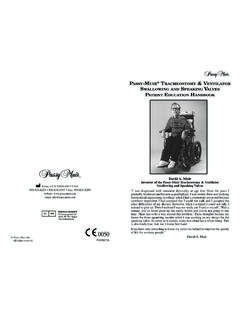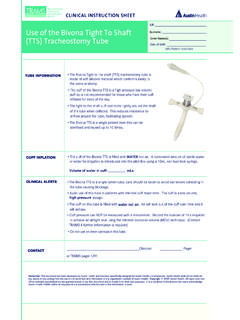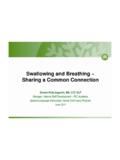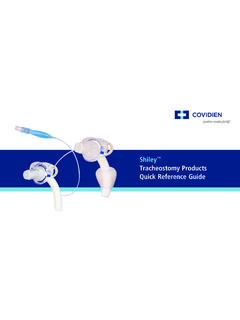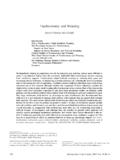Transcription of Techniques of surgical tracheostomy - saithan.net
1 Techniques of surgical tracheostomyPeter A. Walts, MD, Sudish C. Murthy, PhD, MD, Malcolm M. DeCamp, MD*Department of Thoracic and Cardiovascular Surgery, Section of General Thoracic Surgery, The Cleveland Clinic Foundation,9500 Euclid Avenue, Desk F24, Cleveland, OH 44195, USAT racheostomy, from the Greektracheoplusstoma(mouth), strictly defined as the creation of a openingin the trachea by suturing the skin of the neck to thetracheal mucosa, has come to describe the placementof a tube through the anterior neck into a tracheo-tomy, or incision in the trachea. Though there isevidence supporting the possibility that tracheos-tomies date back to 3000 years BC[1], Asclepiadesin the first century BC clearly described their use forthe relief of upper airway obstruction, the principalindication for the next 2000 years[2].
2 A surge in theperformance of tracheostomy in the eighteenth andnineteenth centuries during the diphtheria epidemicresulted in improvements in the technique , but mor-tality in this setting was 73%[3]. Jackson, with hisdescription of the technique in 1909, is credited withthe establishment of the modern tracheostomy as asafe and important part of the surgeon s armamen-tarium[4].The advent of mechanical ventilators and intensivecare units in the 1950s drove a shift in the primaryindication for tracheostomy from emergent relief ofobstruction to elective support for prolonged ventilatordependence. These innovations also prompted a dra-matic increase in the use of tracheostomies[5]. Suchincreased use of the procedure in the critically illpatient, and the evaluation of associated complica-tions, forced refinement of surgical technique andtracheostomy tube design, and served as the impetusesfor the development of new, simpler approaches.
3 Toyand Weinstein introduced the percutaneous tracheos-tomy in 1969[6]. Their technique was modified byCiaglia in 1985 into the modern percutaneous dila-tional tracheostomy [7], the preferred method ofbypassing the upper airway in some article focuses on surgical tracheostomy : theindications, Techniques and complications of one ofthe most commonly performed procedures in con-temporary critical care and timingDespite its long history and frequent use, theindications and timing for tracheostomy remain con-troversial. As with all surgical procedures, the poten-tial benefits to the patient must be carefully weightedagainst the risks. The comorbidities and variability ofpresentation of patients requiring prolonged ventila-tory support make establishing a set of rules govern-ing the use of tracheostomies difficult.
4 Aside fromthose patients requiring permanent tracheostomy fol-lowing laryngectomy, tracheostomy is indicated forrelief of upper airway obstruction, for management ofuncontrolled tracheobronchial secretions, and mostcommonly for prolonged mechanical support due torespiratory insufficiency[8]. The development offiberoptic bronchoscopy, laryngeal mask airways,and translaryngeal endotracheal intubation allowedfor development of the elective tracheostomy . Crea-tion of an emergent surgical airway is now usuallyprecipitated only by severe maxillofacial or laryngealtrauma or significant inhalation injury. Other causesof airway obstruction which may require a tracheos-tomy include oropharyngeal tumors, severe angio-neurotic edema, bilateral vocal cord paralysis, shortsegment tracheomalacia, edema of the airway frominfection or surgery, foreign bodies, and sleep apneaor the Pickwickian syndrome in the morbidly obese[8].
5 In patients with an ineffective cough or excessive0272-5231/03/$ see front matterD2003 Elsevier Inc. All rights (03)00049-2* Corresponding ( DeCamp).Clin Chest Med 24 (2003) 413 422secretions related to bronchiectasis, chronic pneumo-nia, or neurologic or laryngeal dysfunction, tracheos-tomy allows for effective pulmonary toilet[5].The most common yet least clearly defined indi-cation for tracheostomy is the requirement for pro-longed mechanical ventilatory support due torespiratory failure. The potential advantages of tra-cheostomy in this setting include provision of a morestable airway, protection against laryngeal injury,improved pulmonary toilet and oral hygiene, a de-creased requirement for sedation or restraints, facili-tated ventilator weaning, potential for a shorterintensive care unit stay, improved patient comfort,and the potential for speech and oral feeding[9].
6 Although it is generally agreed upon that con-version of an endotracheal tube to a tracheostomy isindicated at some point during a critical illness,opinions regarding the optimal timing and techniquefor the procedure vary widely. Despite the largebody of literature addressing these issues, problemswith study design, the complexity and heterogeneityof the patient population, differing practice patterns,and differing operative Techniques and complicationrates have confounded the search for an answer tothe question of timing[10]. Analysis of availableinformation allows one to draw some conclusions. Itis known that intubation, whether translaryngeal orvia tracheostomy , results in ischemia, ulceration, andsubsequent stenosis at pressure points between thetube, its cuff, and the tracheal mucosa.
7 The intro-duction of high-volume, low-pressure cuffs in bothtracheostomy and endotracheal tube design has de-creased the incidence of cuff-related airway stenosis,but laryngeal injury and subglottic and trachealstenosis remain significant clinical problems[11].In a prospective study of 200 patients, Whited founda linear correlation between duration of intubationand not only incidence, but also severity, of laryn-geal injury. In those patients intubated less than5 days there were no long-term complications. After6 to 10 days there was a 5% incidence of chronicstenosis, and those intubated for longer than 11 dayshad a 12% incidence of chronic stenosis that wasconsistently more extensive[12]. Although a num-ber of studies in which the incidence of postintuba-tion airway stenosis was extremely low have refutedthis correlation, differences in patient population andthe etiology for respiratory failure may account forsome of these differences[10,13 15].
8 Interestingly,a second pattern of non time-related, postintubationlaryngeal injuries such as hoarseness, arytenoiddislocation, vocal cord paralysis, and glottic incom-petence was uncovered at an incidence of 19% byColice et al[13]. These data argue against the roleof tracheostomy in preventing some forms of laryn-geal by definition, stenosis will occur to somedegree at the tracheal stoma; however, the incidenceof symptomatic tracheal stenosis is low, and com-pared with laryngeal stenosis, much easier to treat. Inthe patient meeting other criteria for conversion fromtranslaryngeal intubation to a tracheostomy , the riskof stomal stenosis should not factor into the primary argument against tracheostomyrevolves around the incidence of surgical complica-tions, which again vary widely in the reported a 66% complication rate with trache-ostomy in contrast to a generally accepted 5% to 6%[5,16].
9 Although his study is flawed by the widevariability in surgeons experience and biased by notaccounting for the length of intubation before tracheos-tomy, Stauffer correctly emphasizes the meticuloustechnique and attention to detail required to achievegood outcome in tracheostomy construction[16].The optimal timing of elective tracheostomyremains nebulous, and universal selection criteriacannot be broadly applied. The choice to convert totracheostomy must be individualized based on anumber of factors. The approach that we encouragesets a horizon some 7 to 10 days after intubation as thefirst point in the decision tree. If a patient remainsintubated at this point and clearly is not going to beextubatable in the next week, a tracheostomy shouldbe done, assuming an acceptable surgical risk and thatthe patient is hemodynamically stable.
10 Waiting thisinitial week also will minimize the number of unnec-essary tracheostomies. Beyond this point, the risk ofsevere laryngeal injury, the need for a stable airway,effective pulmonary toilet, and improved patient com-fort begin to shift the risk-benefit ratio in favor oftracheostomy. If the prognosis for recovery is uncer-tain, careful daily reassessment of the patient s prog-ress over the next few days will allow accurateprediction of the likelihood for extubation. We advo-cate setting a limit between 10 and 14 days, at whichtime a definitive decision is made. Though tradi-tionally the bias has been to try to avoid tracheostomy ,our bias is that the benefits of early tracheostomy faroutweigh the risks of prolonged translaryngeal intu-bation, which also include the risk of self-extubationor reintubation for failed planned on the person s size, the adult trachearanges from 10 cm to 13 cm in length from the larynxto the carina.

